Strategic Management and Technological Innovation in Healthcare Sector
VerifiedAdded on 2021/02/19
|15
|2093
|33
Report
AI Summary
This report investigates the impact of technological innovation on strategic management within the healthcare sector, specifically focusing on the National Health Service (NHS). It examines the aims and objectives of assessing how technology has assisted healthcare, including identifying strategic management practices and investigating the contribution of technological advancements. The research utilizes a qualitative methodology, employing inductive approaches and interpretivism philosophy, with purposive sampling and data collection through interviews and questionnaires from NHS strategic managers. The findings, analyzed thematically, reveal that technological innovation has improved service quality, enabled early disease detection, and enhanced patient satisfaction. However, the report also acknowledges increased costs and potential privacy concerns. The conclusion emphasizes the benefits of strategic planning in technology implementation for efficient resource allocation and improved healthcare services. Recommendations include adopting cost-effective technologies and leveraging strategic management for competitive advantage, while the reflection highlights the improvements in business performance and patient care. The report references relevant books, journals, and online resources to support its findings.
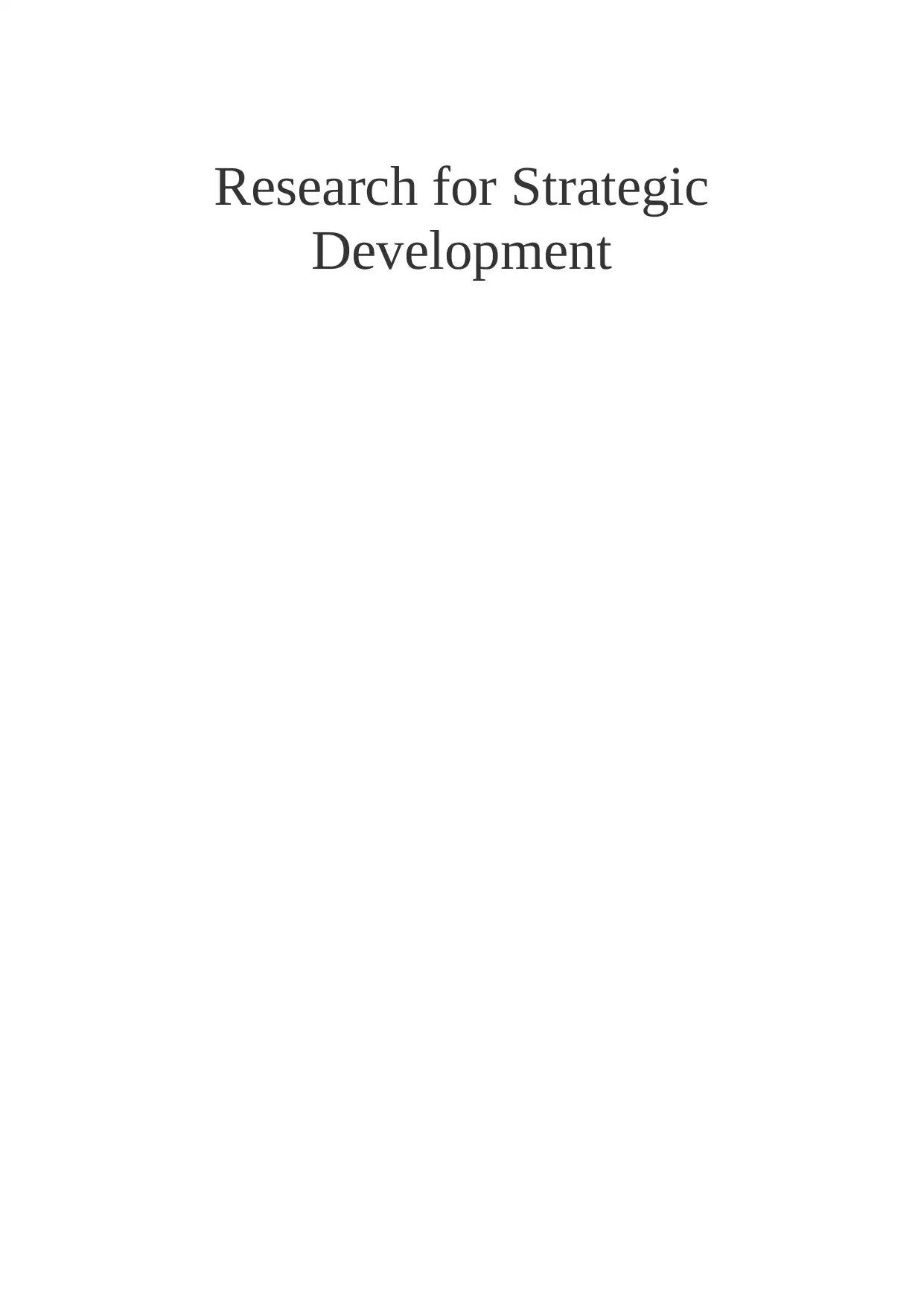
Research for Strategic
Development
Development
Paraphrase This Document
Need a fresh take? Get an instant paraphrase of this document with our AI Paraphraser

Table of Contents
Background...........................................................................................................................................3
Aims and Objectives.............................................................................................................................3
Research Questions..............................................................................................................................3
Rationale...............................................................................................................................................3
Significance..........................................................................................................................................4
Research Methodology.........................................................................................................................4
Time line...............................................................................................................................................5
LITERATURE REVIEW.....................................................................................................................5
RESEARCH METHODOLOGY.........................................................................................................7
Research Type.............................................................................................................................7
Data Analysis..............................................................................................................................9
....................................................................................................................................................9
CONCLUSION .................................................................................................................................13
RECOMMENDATION......................................................................................................................13
REFLECTION....................................................................................................................................13
REFERENCES...................................................................................................................................15
Background...........................................................................................................................................3
Aims and Objectives.............................................................................................................................3
Research Questions..............................................................................................................................3
Rationale...............................................................................................................................................3
Significance..........................................................................................................................................4
Research Methodology.........................................................................................................................4
Time line...............................................................................................................................................5
LITERATURE REVIEW.....................................................................................................................5
RESEARCH METHODOLOGY.........................................................................................................7
Research Type.............................................................................................................................7
Data Analysis..............................................................................................................................9
....................................................................................................................................................9
CONCLUSION .................................................................................................................................13
RECOMMENDATION......................................................................................................................13
REFLECTION....................................................................................................................................13
REFERENCES...................................................................................................................................15
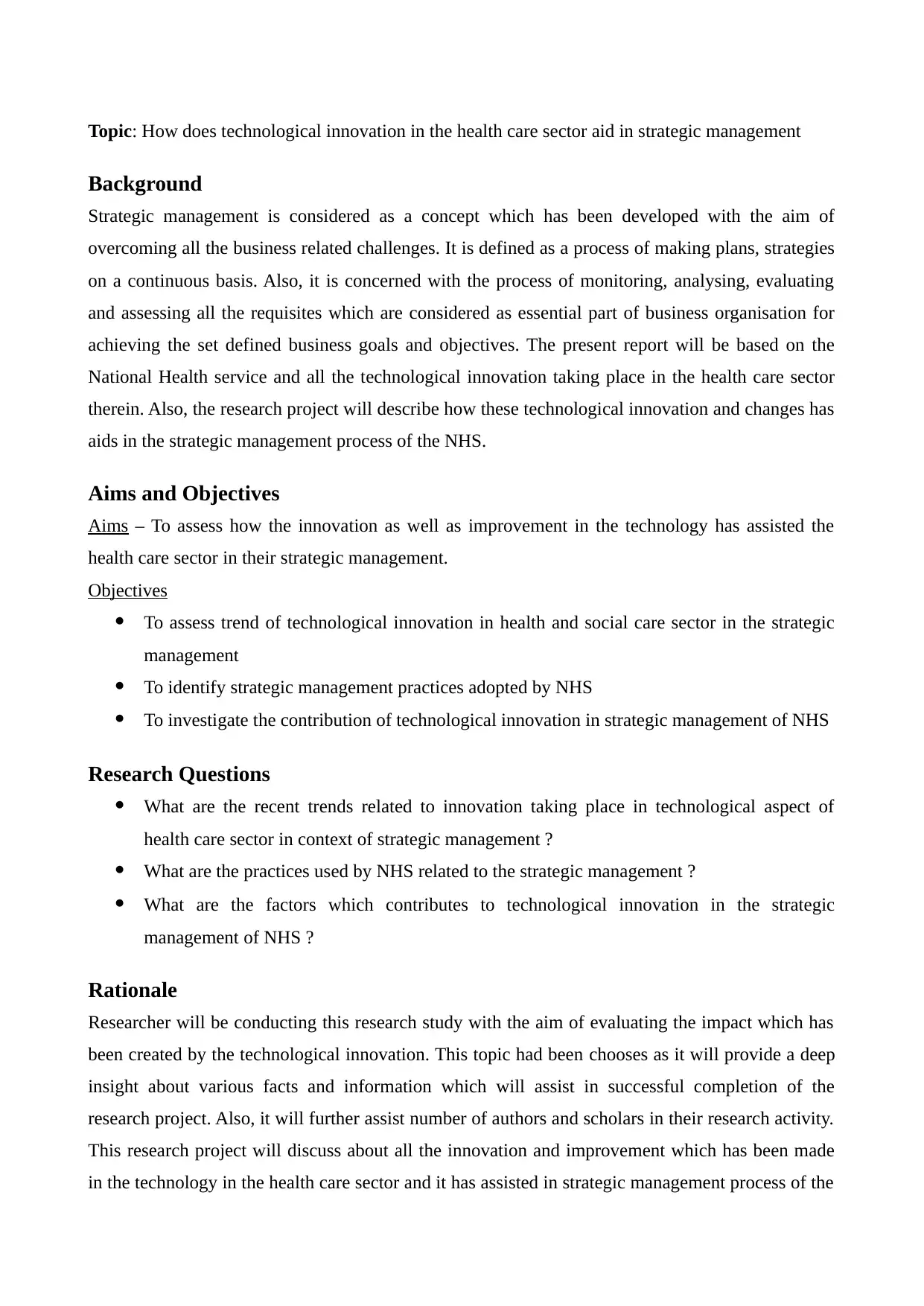
Topic: How does technological innovation in the health care sector aid in strategic management
Background
Strategic management is considered as a concept which has been developed with the aim of
overcoming all the business related challenges. It is defined as a process of making plans, strategies
on a continuous basis. Also, it is concerned with the process of monitoring, analysing, evaluating
and assessing all the requisites which are considered as essential part of business organisation for
achieving the set defined business goals and objectives. The present report will be based on the
National Health service and all the technological innovation taking place in the health care sector
therein. Also, the research project will describe how these technological innovation and changes has
aids in the strategic management process of the NHS.
Aims and Objectives
Aims – To assess how the innovation as well as improvement in the technology has assisted the
health care sector in their strategic management.
Objectives
To assess trend of technological innovation in health and social care sector in the strategic
management
To identify strategic management practices adopted by NHS
To investigate the contribution of technological innovation in strategic management of NHS
Research Questions
What are the recent trends related to innovation taking place in technological aspect of
health care sector in context of strategic management ?
What are the practices used by NHS related to the strategic management ?
What are the factors which contributes to technological innovation in the strategic
management of NHS ?
Rationale
Researcher will be conducting this research study with the aim of evaluating the impact which has
been created by the technological innovation. This topic had been chooses as it will provide a deep
insight about various facts and information which will assist in successful completion of the
research project. Also, it will further assist number of authors and scholars in their research activity.
This research project will discuss about all the innovation and improvement which has been made
in the technology in the health care sector and it has assisted in strategic management process of the
Background
Strategic management is considered as a concept which has been developed with the aim of
overcoming all the business related challenges. It is defined as a process of making plans, strategies
on a continuous basis. Also, it is concerned with the process of monitoring, analysing, evaluating
and assessing all the requisites which are considered as essential part of business organisation for
achieving the set defined business goals and objectives. The present report will be based on the
National Health service and all the technological innovation taking place in the health care sector
therein. Also, the research project will describe how these technological innovation and changes has
aids in the strategic management process of the NHS.
Aims and Objectives
Aims – To assess how the innovation as well as improvement in the technology has assisted the
health care sector in their strategic management.
Objectives
To assess trend of technological innovation in health and social care sector in the strategic
management
To identify strategic management practices adopted by NHS
To investigate the contribution of technological innovation in strategic management of NHS
Research Questions
What are the recent trends related to innovation taking place in technological aspect of
health care sector in context of strategic management ?
What are the practices used by NHS related to the strategic management ?
What are the factors which contributes to technological innovation in the strategic
management of NHS ?
Rationale
Researcher will be conducting this research study with the aim of evaluating the impact which has
been created by the technological innovation. This topic had been chooses as it will provide a deep
insight about various facts and information which will assist in successful completion of the
research project. Also, it will further assist number of authors and scholars in their research activity.
This research project will discuss about all the innovation and improvement which has been made
in the technology in the health care sector and it has assisted in strategic management process of the
⊘ This is a preview!⊘
Do you want full access?
Subscribe today to unlock all pages.

Trusted by 1+ million students worldwide
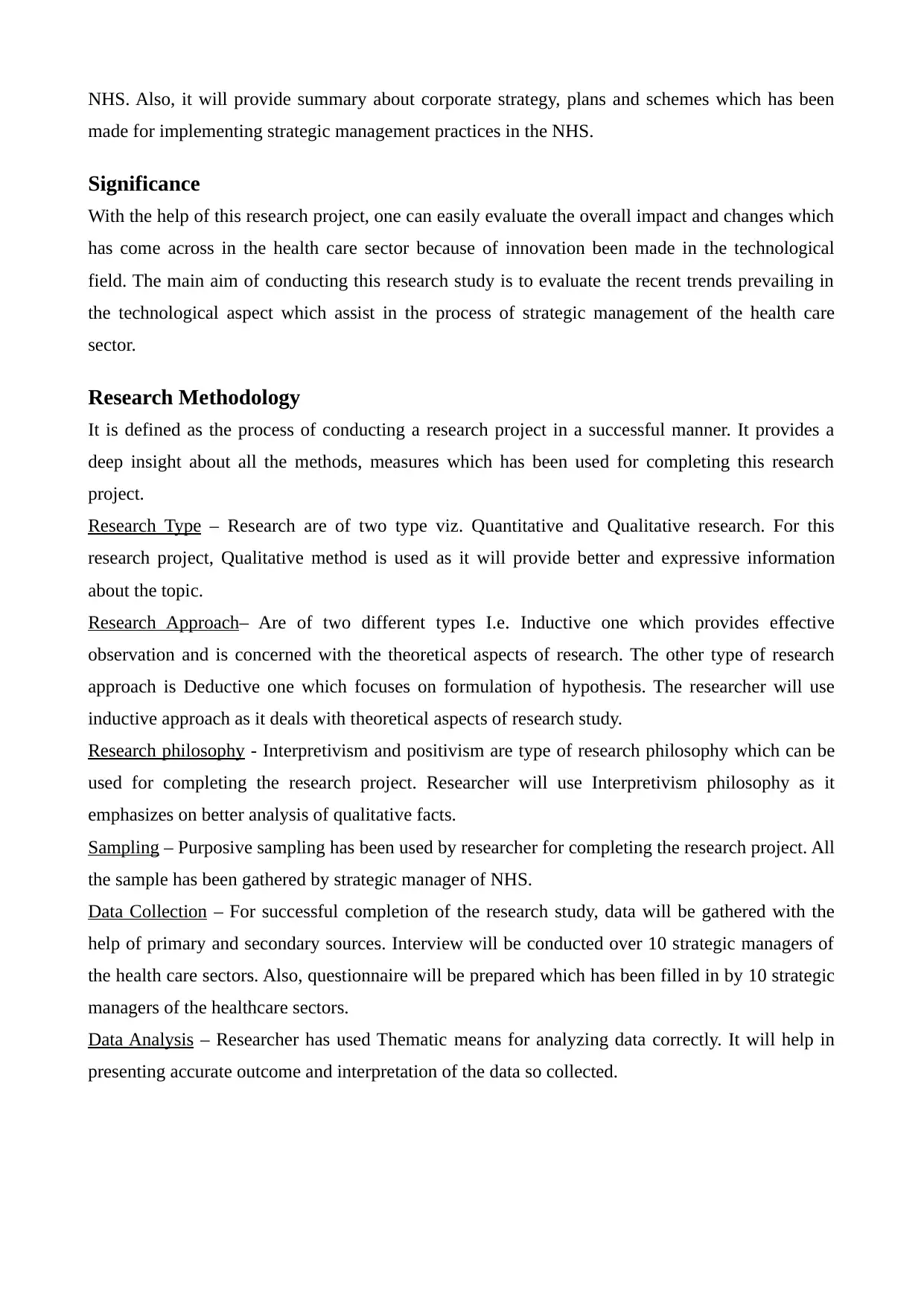
NHS. Also, it will provide summary about corporate strategy, plans and schemes which has been
made for implementing strategic management practices in the NHS.
Significance
With the help of this research project, one can easily evaluate the overall impact and changes which
has come across in the health care sector because of innovation been made in the technological
field. The main aim of conducting this research study is to evaluate the recent trends prevailing in
the technological aspect which assist in the process of strategic management of the health care
sector.
Research Methodology
It is defined as the process of conducting a research project in a successful manner. It provides a
deep insight about all the methods, measures which has been used for completing this research
project.
Research Type – Research are of two type viz. Quantitative and Qualitative research. For this
research project, Qualitative method is used as it will provide better and expressive information
about the topic.
Research Approach– Are of two different types I.e. Inductive one which provides effective
observation and is concerned with the theoretical aspects of research. The other type of research
approach is Deductive one which focuses on formulation of hypothesis. The researcher will use
inductive approach as it deals with theoretical aspects of research study.
Research philosophy - Interpretivism and positivism are type of research philosophy which can be
used for completing the research project. Researcher will use Interpretivism philosophy as it
emphasizes on better analysis of qualitative facts.
Sampling – Purposive sampling has been used by researcher for completing the research project. All
the sample has been gathered by strategic manager of NHS.
Data Collection – For successful completion of the research study, data will be gathered with the
help of primary and secondary sources. Interview will be conducted over 10 strategic managers of
the health care sectors. Also, questionnaire will be prepared which has been filled in by 10 strategic
managers of the healthcare sectors.
Data Analysis – Researcher has used Thematic means for analyzing data correctly. It will help in
presenting accurate outcome and interpretation of the data so collected.
made for implementing strategic management practices in the NHS.
Significance
With the help of this research project, one can easily evaluate the overall impact and changes which
has come across in the health care sector because of innovation been made in the technological
field. The main aim of conducting this research study is to evaluate the recent trends prevailing in
the technological aspect which assist in the process of strategic management of the health care
sector.
Research Methodology
It is defined as the process of conducting a research project in a successful manner. It provides a
deep insight about all the methods, measures which has been used for completing this research
project.
Research Type – Research are of two type viz. Quantitative and Qualitative research. For this
research project, Qualitative method is used as it will provide better and expressive information
about the topic.
Research Approach– Are of two different types I.e. Inductive one which provides effective
observation and is concerned with the theoretical aspects of research. The other type of research
approach is Deductive one which focuses on formulation of hypothesis. The researcher will use
inductive approach as it deals with theoretical aspects of research study.
Research philosophy - Interpretivism and positivism are type of research philosophy which can be
used for completing the research project. Researcher will use Interpretivism philosophy as it
emphasizes on better analysis of qualitative facts.
Sampling – Purposive sampling has been used by researcher for completing the research project. All
the sample has been gathered by strategic manager of NHS.
Data Collection – For successful completion of the research study, data will be gathered with the
help of primary and secondary sources. Interview will be conducted over 10 strategic managers of
the health care sectors. Also, questionnaire will be prepared which has been filled in by 10 strategic
managers of the healthcare sectors.
Data Analysis – Researcher has used Thematic means for analyzing data correctly. It will help in
presenting accurate outcome and interpretation of the data so collected.
Paraphrase This Document
Need a fresh take? Get an instant paraphrase of this document with our AI Paraphraser
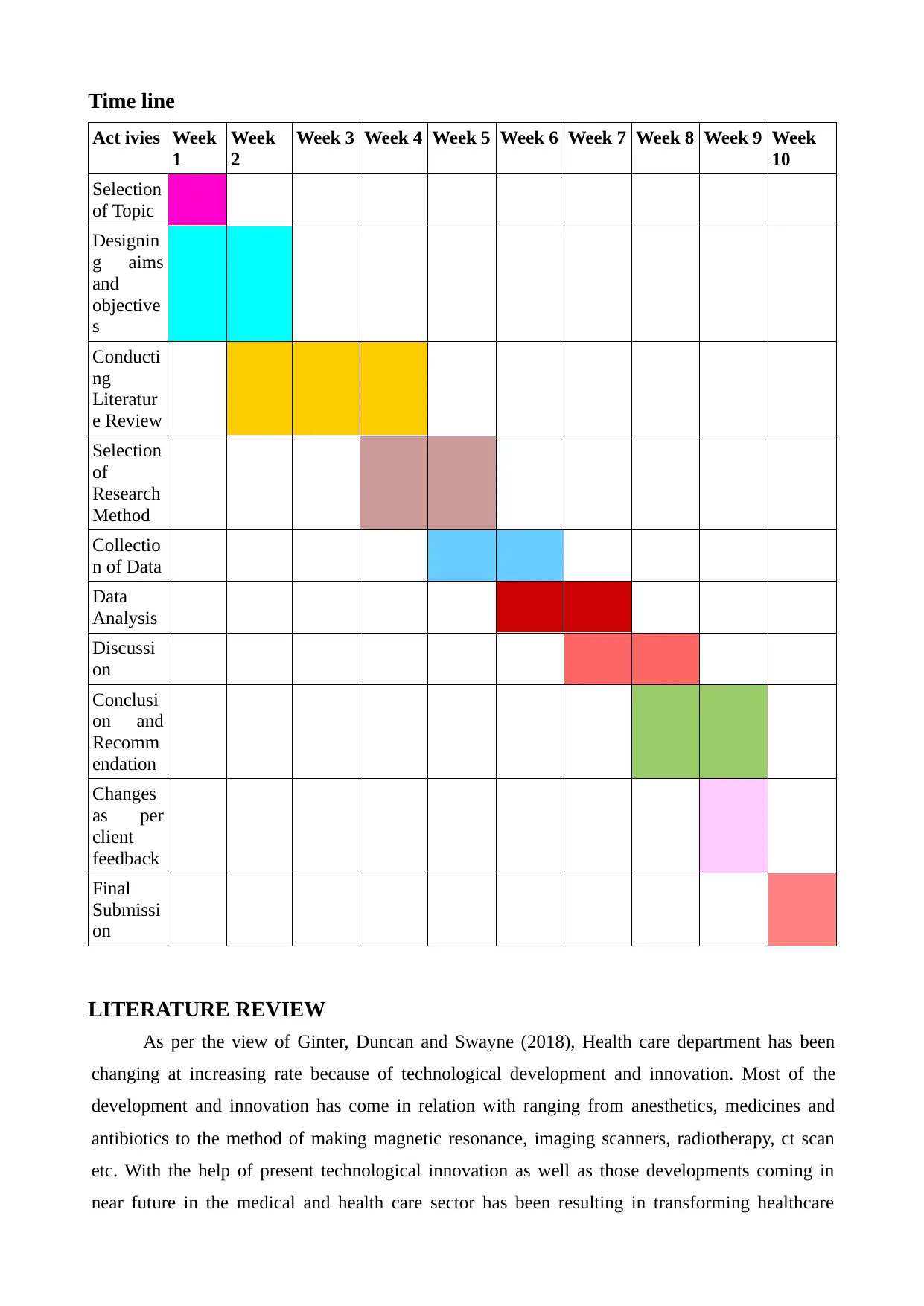
Time line
Act ivies Week
1
Week
2
Week 3 Week 4 Week 5 Week 6 Week 7 Week 8 Week 9 Week
10
Selection
of Topic
Designin
g aims
and
objective
s
Conducti
ng
Literatur
e Review
Selection
of
Research
Method
Collectio
n of Data
Data
Analysis
Discussi
on
Conclusi
on and
Recomm
endation
Changes
as per
client
feedback
Final
Submissi
on
LITERATURE REVIEW
As per the view of Ginter, Duncan and Swayne (2018), Health care department has been
changing at increasing rate because of technological development and innovation. Most of the
development and innovation has come in relation with ranging from anesthetics, medicines and
antibiotics to the method of making magnetic resonance, imaging scanners, radiotherapy, ct scan
etc. With the help of present technological innovation as well as those developments coming in
near future in the medical and health care sector has been resulting in transforming healthcare
Act ivies Week
1
Week
2
Week 3 Week 4 Week 5 Week 6 Week 7 Week 8 Week 9 Week
10
Selection
of Topic
Designin
g aims
and
objective
s
Conducti
ng
Literatur
e Review
Selection
of
Research
Method
Collectio
n of Data
Data
Analysis
Discussi
on
Conclusi
on and
Recomm
endation
Changes
as per
client
feedback
Final
Submissi
on
LITERATURE REVIEW
As per the view of Ginter, Duncan and Swayne (2018), Health care department has been
changing at increasing rate because of technological development and innovation. Most of the
development and innovation has come in relation with ranging from anesthetics, medicines and
antibiotics to the method of making magnetic resonance, imaging scanners, radiotherapy, ct scan
etc. With the help of present technological innovation as well as those developments coming in
near future in the medical and health care sector has been resulting in transforming healthcare
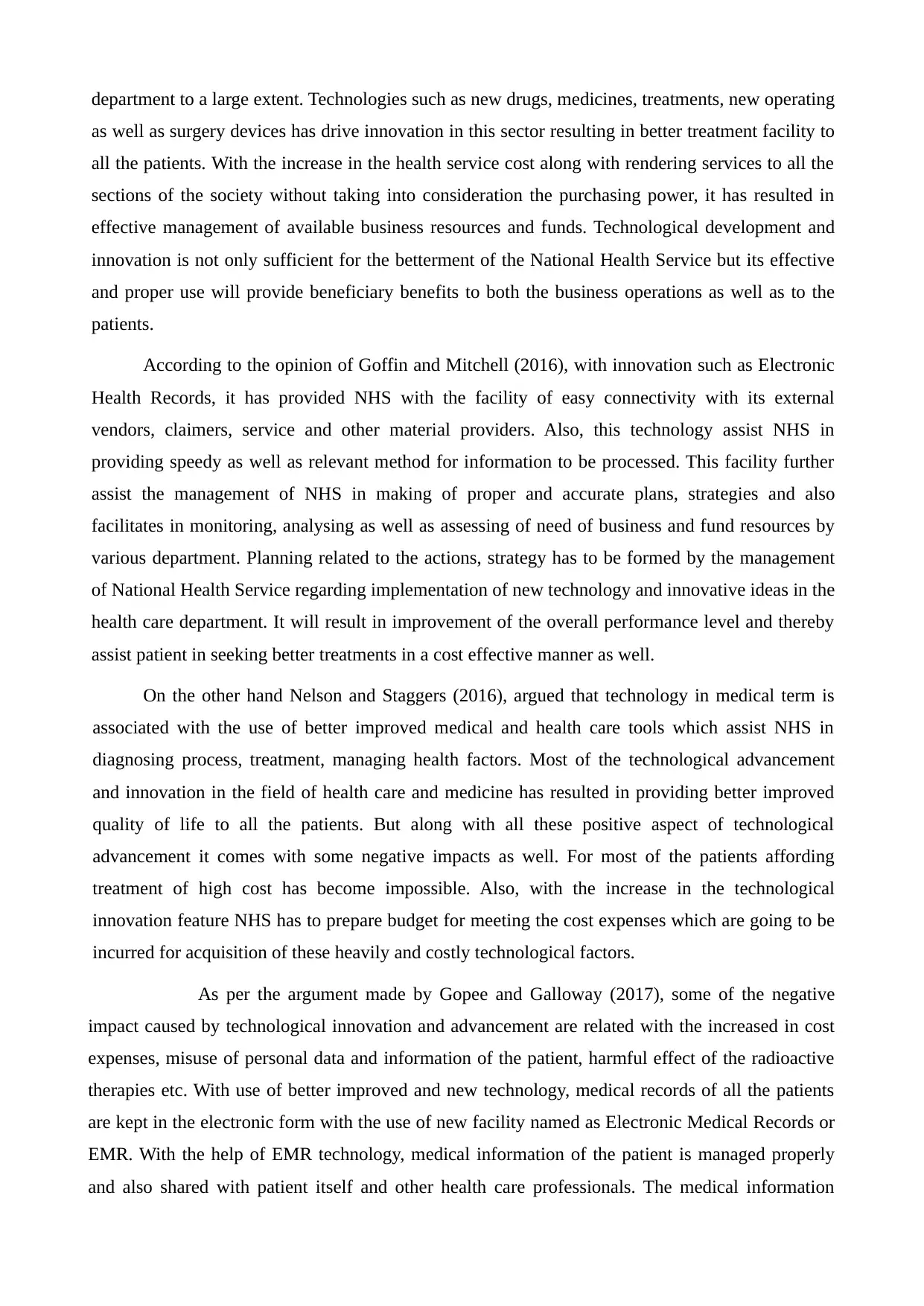
department to a large extent. Technologies such as new drugs, medicines, treatments, new operating
as well as surgery devices has drive innovation in this sector resulting in better treatment facility to
all the patients. With the increase in the health service cost along with rendering services to all the
sections of the society without taking into consideration the purchasing power, it has resulted in
effective management of available business resources and funds. Technological development and
innovation is not only sufficient for the betterment of the National Health Service but its effective
and proper use will provide beneficiary benefits to both the business operations as well as to the
patients.
According to the opinion of Goffin and Mitchell (2016), with innovation such as Electronic
Health Records, it has provided NHS with the facility of easy connectivity with its external
vendors, claimers, service and other material providers. Also, this technology assist NHS in
providing speedy as well as relevant method for information to be processed. This facility further
assist the management of NHS in making of proper and accurate plans, strategies and also
facilitates in monitoring, analysing as well as assessing of need of business and fund resources by
various department. Planning related to the actions, strategy has to be formed by the management
of National Health Service regarding implementation of new technology and innovative ideas in the
health care department. It will result in improvement of the overall performance level and thereby
assist patient in seeking better treatments in a cost effective manner as well.
On the other hand Nelson and Staggers (2016), argued that technology in medical term is
associated with the use of better improved medical and health care tools which assist NHS in
diagnosing process, treatment, managing health factors. Most of the technological advancement
and innovation in the field of health care and medicine has resulted in providing better improved
quality of life to all the patients. But along with all these positive aspect of technological
advancement it comes with some negative impacts as well. For most of the patients affording
treatment of high cost has become impossible. Also, with the increase in the technological
innovation feature NHS has to prepare budget for meeting the cost expenses which are going to be
incurred for acquisition of these heavily and costly technological factors.
As per the argument made by Gopee and Galloway (2017), some of the negative
impact caused by technological innovation and advancement are related with the increased in cost
expenses, misuse of personal data and information of the patient, harmful effect of the radioactive
therapies etc. With use of better improved and new technology, medical records of all the patients
are kept in the electronic form with the use of new facility named as Electronic Medical Records or
EMR. With the help of EMR technology, medical information of the patient is managed properly
and also shared with patient itself and other health care professionals. The medical information
as well as surgery devices has drive innovation in this sector resulting in better treatment facility to
all the patients. With the increase in the health service cost along with rendering services to all the
sections of the society without taking into consideration the purchasing power, it has resulted in
effective management of available business resources and funds. Technological development and
innovation is not only sufficient for the betterment of the National Health Service but its effective
and proper use will provide beneficiary benefits to both the business operations as well as to the
patients.
According to the opinion of Goffin and Mitchell (2016), with innovation such as Electronic
Health Records, it has provided NHS with the facility of easy connectivity with its external
vendors, claimers, service and other material providers. Also, this technology assist NHS in
providing speedy as well as relevant method for information to be processed. This facility further
assist the management of NHS in making of proper and accurate plans, strategies and also
facilitates in monitoring, analysing as well as assessing of need of business and fund resources by
various department. Planning related to the actions, strategy has to be formed by the management
of National Health Service regarding implementation of new technology and innovative ideas in the
health care department. It will result in improvement of the overall performance level and thereby
assist patient in seeking better treatments in a cost effective manner as well.
On the other hand Nelson and Staggers (2016), argued that technology in medical term is
associated with the use of better improved medical and health care tools which assist NHS in
diagnosing process, treatment, managing health factors. Most of the technological advancement
and innovation in the field of health care and medicine has resulted in providing better improved
quality of life to all the patients. But along with all these positive aspect of technological
advancement it comes with some negative impacts as well. For most of the patients affording
treatment of high cost has become impossible. Also, with the increase in the technological
innovation feature NHS has to prepare budget for meeting the cost expenses which are going to be
incurred for acquisition of these heavily and costly technological factors.
As per the argument made by Gopee and Galloway (2017), some of the negative
impact caused by technological innovation and advancement are related with the increased in cost
expenses, misuse of personal data and information of the patient, harmful effect of the radioactive
therapies etc. With use of better improved and new technology, medical records of all the patients
are kept in the electronic form with the use of new facility named as Electronic Medical Records or
EMR. With the help of EMR technology, medical information of the patient is managed properly
and also shared with patient itself and other health care professionals. The medical information
⊘ This is a preview!⊘
Do you want full access?
Subscribe today to unlock all pages.

Trusted by 1+ million students worldwide
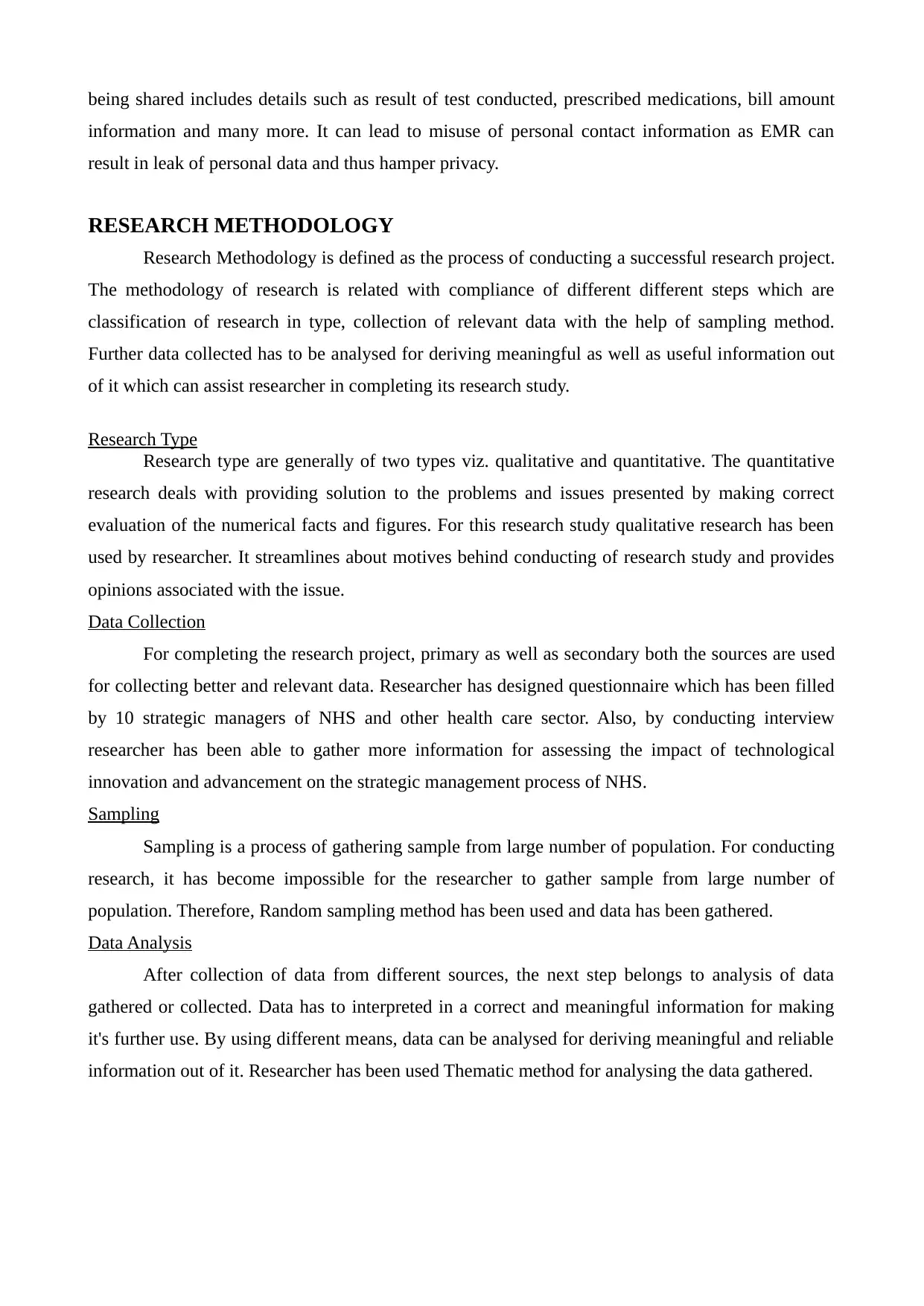
being shared includes details such as result of test conducted, prescribed medications, bill amount
information and many more. It can lead to misuse of personal contact information as EMR can
result in leak of personal data and thus hamper privacy.
RESEARCH METHODOLOGY
Research Methodology is defined as the process of conducting a successful research project.
The methodology of research is related with compliance of different different steps which are
classification of research in type, collection of relevant data with the help of sampling method.
Further data collected has to be analysed for deriving meaningful as well as useful information out
of it which can assist researcher in completing its research study.
Research Type
Research type are generally of two types viz. qualitative and quantitative. The quantitative
research deals with providing solution to the problems and issues presented by making correct
evaluation of the numerical facts and figures. For this research study qualitative research has been
used by researcher. It streamlines about motives behind conducting of research study and provides
opinions associated with the issue.
Data Collection
For completing the research project, primary as well as secondary both the sources are used
for collecting better and relevant data. Researcher has designed questionnaire which has been filled
by 10 strategic managers of NHS and other health care sector. Also, by conducting interview
researcher has been able to gather more information for assessing the impact of technological
innovation and advancement on the strategic management process of NHS.
Sampling
Sampling is a process of gathering sample from large number of population. For conducting
research, it has become impossible for the researcher to gather sample from large number of
population. Therefore, Random sampling method has been used and data has been gathered.
Data Analysis
After collection of data from different sources, the next step belongs to analysis of data
gathered or collected. Data has to interpreted in a correct and meaningful information for making
it's further use. By using different means, data can be analysed for deriving meaningful and reliable
information out of it. Researcher has been used Thematic method for analysing the data gathered.
information and many more. It can lead to misuse of personal contact information as EMR can
result in leak of personal data and thus hamper privacy.
RESEARCH METHODOLOGY
Research Methodology is defined as the process of conducting a successful research project.
The methodology of research is related with compliance of different different steps which are
classification of research in type, collection of relevant data with the help of sampling method.
Further data collected has to be analysed for deriving meaningful as well as useful information out
of it which can assist researcher in completing its research study.
Research Type
Research type are generally of two types viz. qualitative and quantitative. The quantitative
research deals with providing solution to the problems and issues presented by making correct
evaluation of the numerical facts and figures. For this research study qualitative research has been
used by researcher. It streamlines about motives behind conducting of research study and provides
opinions associated with the issue.
Data Collection
For completing the research project, primary as well as secondary both the sources are used
for collecting better and relevant data. Researcher has designed questionnaire which has been filled
by 10 strategic managers of NHS and other health care sector. Also, by conducting interview
researcher has been able to gather more information for assessing the impact of technological
innovation and advancement on the strategic management process of NHS.
Sampling
Sampling is a process of gathering sample from large number of population. For conducting
research, it has become impossible for the researcher to gather sample from large number of
population. Therefore, Random sampling method has been used and data has been gathered.
Data Analysis
After collection of data from different sources, the next step belongs to analysis of data
gathered or collected. Data has to interpreted in a correct and meaningful information for making
it's further use. By using different means, data can be analysed for deriving meaningful and reliable
information out of it. Researcher has been used Thematic method for analysing the data gathered.
Paraphrase This Document
Need a fresh take? Get an instant paraphrase of this document with our AI Paraphraser
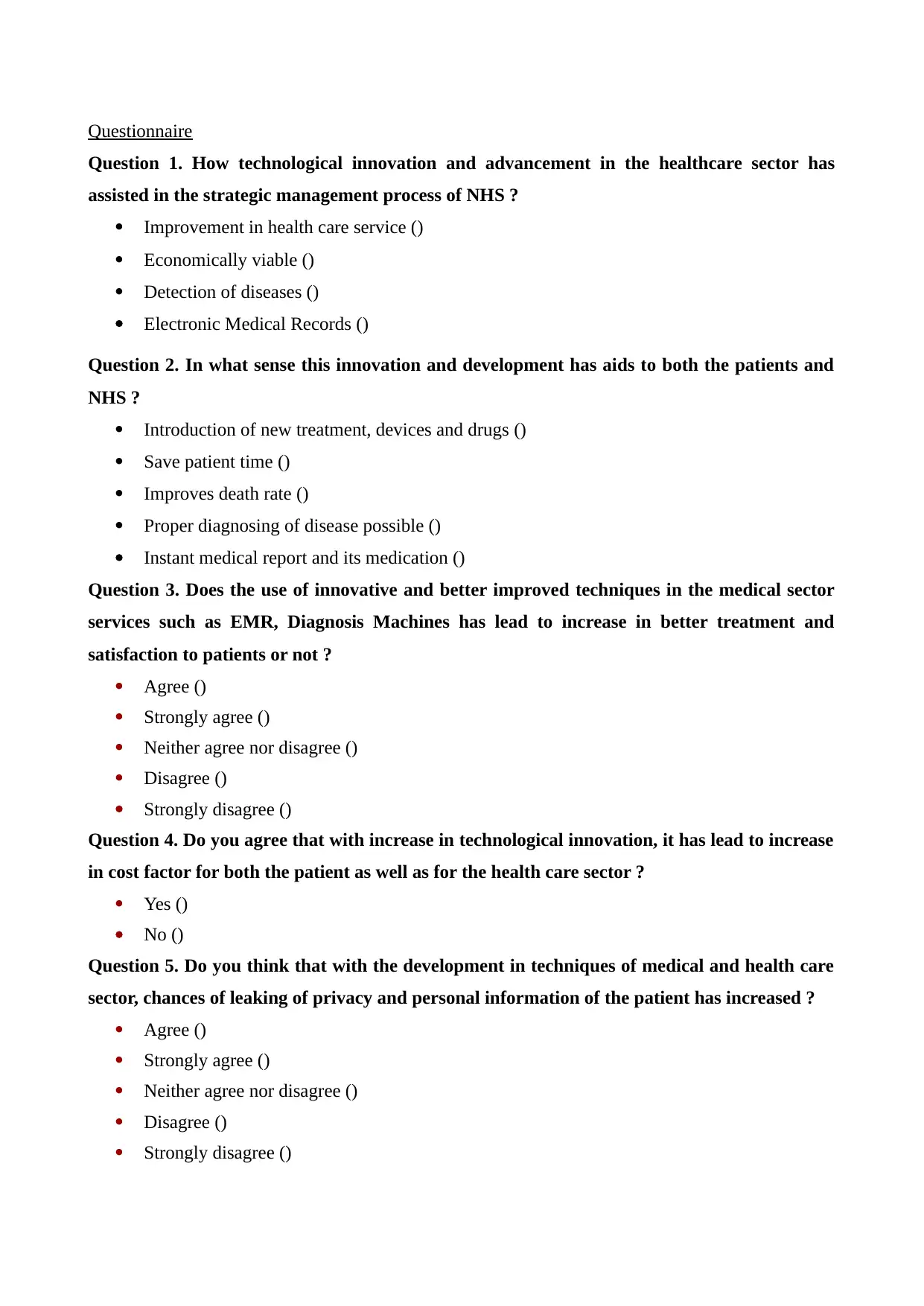
Questionnaire
Question 1. How technological innovation and advancement in the healthcare sector has
assisted in the strategic management process of NHS ?
Improvement in health care service ()
Economically viable ()
Detection of diseases ()
Electronic Medical Records ()
Question 2. In what sense this innovation and development has aids to both the patients and
NHS ?
Introduction of new treatment, devices and drugs ()
Save patient time ()
Improves death rate ()
Proper diagnosing of disease possible ()
Instant medical report and its medication ()
Question 3. Does the use of innovative and better improved techniques in the medical sector
services such as EMR, Diagnosis Machines has lead to increase in better treatment and
satisfaction to patients or not ?
Agree ()
Strongly agree ()
Neither agree nor disagree ()
Disagree ()
Strongly disagree ()
Question 4. Do you agree that with increase in technological innovation, it has lead to increase
in cost factor for both the patient as well as for the health care sector ?
Yes ()
No ()
Question 5. Do you think that with the development in techniques of medical and health care
sector, chances of leaking of privacy and personal information of the patient has increased ?
Agree ()
Strongly agree ()
Neither agree nor disagree ()
Disagree ()
Strongly disagree ()
Question 1. How technological innovation and advancement in the healthcare sector has
assisted in the strategic management process of NHS ?
Improvement in health care service ()
Economically viable ()
Detection of diseases ()
Electronic Medical Records ()
Question 2. In what sense this innovation and development has aids to both the patients and
NHS ?
Introduction of new treatment, devices and drugs ()
Save patient time ()
Improves death rate ()
Proper diagnosing of disease possible ()
Instant medical report and its medication ()
Question 3. Does the use of innovative and better improved techniques in the medical sector
services such as EMR, Diagnosis Machines has lead to increase in better treatment and
satisfaction to patients or not ?
Agree ()
Strongly agree ()
Neither agree nor disagree ()
Disagree ()
Strongly disagree ()
Question 4. Do you agree that with increase in technological innovation, it has lead to increase
in cost factor for both the patient as well as for the health care sector ?
Yes ()
No ()
Question 5. Do you think that with the development in techniques of medical and health care
sector, chances of leaking of privacy and personal information of the patient has increased ?
Agree ()
Strongly agree ()
Neither agree nor disagree ()
Disagree ()
Strongly disagree ()
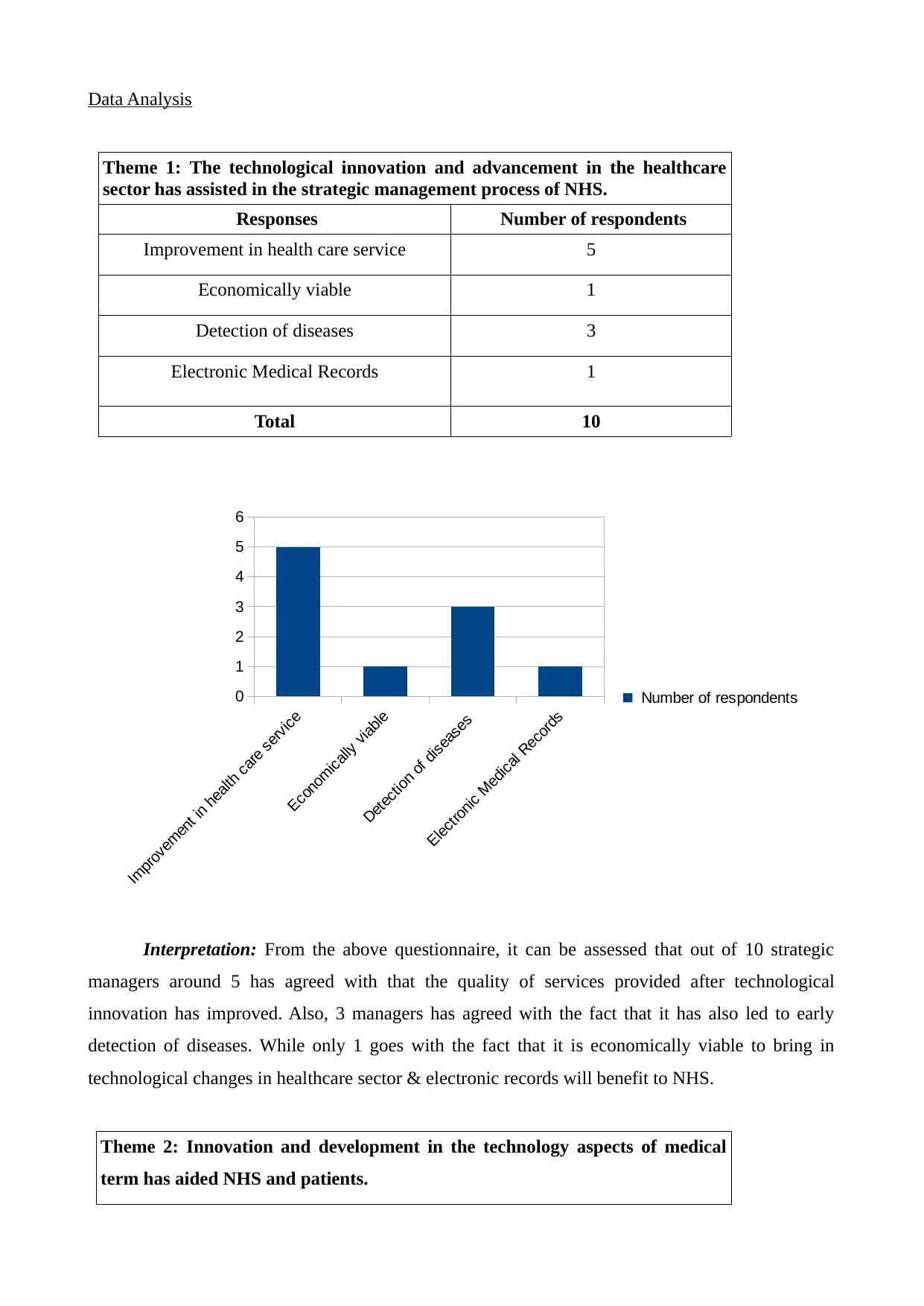
Data Analysis
Theme 1: The technological innovation and advancement in the healthcare
sector has assisted in the strategic management process of NHS.
Responses Number of respondents
Improvement in health care service 5
Economically viable 1
Detection of diseases 3
Electronic Medical Records 1
Total 10
Interpretation: From the above questionnaire, it can be assessed that out of 10 strategic
managers around 5 has agreed with that the quality of services provided after technological
innovation has improved. Also, 3 managers has agreed with the fact that it has also led to early
detection of diseases. While only 1 goes with the fact that it is economically viable to bring in
technological changes in healthcare sector & electronic records will benefit to NHS.
Theme 2: Innovation and development in the technology aspects of medical
term has aided NHS and patients.
Improvement in health care service
Economically viable
Detection of diseases
Electronic Medical Records
0
1
2
3
4
5
6
Number of respondents
Theme 1: The technological innovation and advancement in the healthcare
sector has assisted in the strategic management process of NHS.
Responses Number of respondents
Improvement in health care service 5
Economically viable 1
Detection of diseases 3
Electronic Medical Records 1
Total 10
Interpretation: From the above questionnaire, it can be assessed that out of 10 strategic
managers around 5 has agreed with that the quality of services provided after technological
innovation has improved. Also, 3 managers has agreed with the fact that it has also led to early
detection of diseases. While only 1 goes with the fact that it is economically viable to bring in
technological changes in healthcare sector & electronic records will benefit to NHS.
Theme 2: Innovation and development in the technology aspects of medical
term has aided NHS and patients.
Improvement in health care service
Economically viable
Detection of diseases
Electronic Medical Records
0
1
2
3
4
5
6
Number of respondents
⊘ This is a preview!⊘
Do you want full access?
Subscribe today to unlock all pages.

Trusted by 1+ million students worldwide
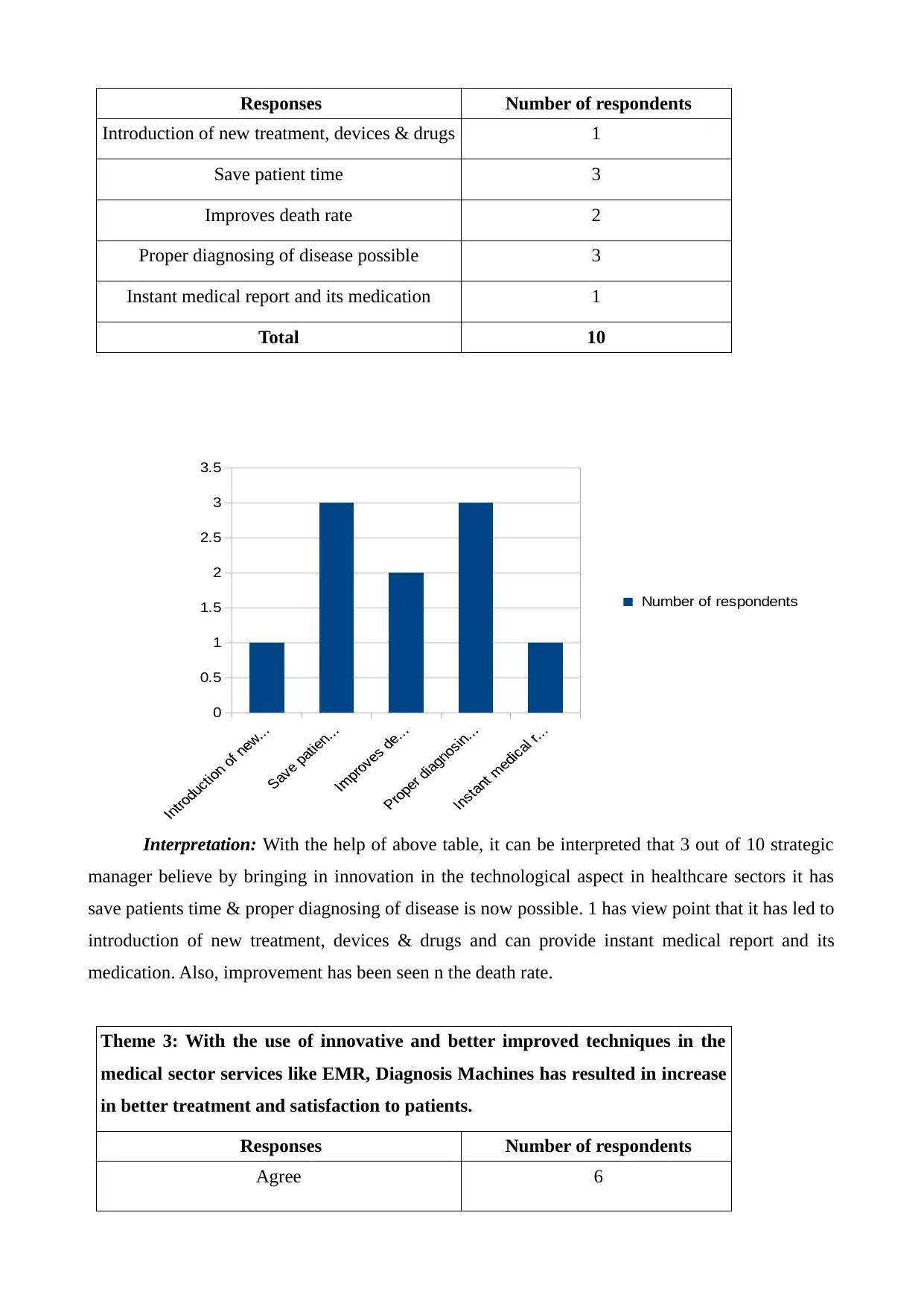
Responses Number of respondents
Introduction of new treatment, devices & drugs 1
Save patient time 3
Improves death rate 2
Proper diagnosing of disease possible 3
Instant medical report and its medication 1
Total 10
Interpretation: With the help of above table, it can be interpreted that 3 out of 10 strategic
manager believe by bringing in innovation in the technological aspect in healthcare sectors it has
save patients time & proper diagnosing of disease is now possible. 1 has view point that it has led to
introduction of new treatment, devices & drugs and can provide instant medical report and its
medication. Also, improvement has been seen n the death rate.
Theme 3: With the use of innovative and better improved techniques in the
medical sector services like EMR, Diagnosis Machines has resulted in increase
in better treatment and satisfaction to patients.
Responses Number of respondents
Agree 6
0
0.5
1
1.5
2
2.5
3
3.5
Number of respondents
Introduction of new treatment, devices & drugs 1
Save patient time 3
Improves death rate 2
Proper diagnosing of disease possible 3
Instant medical report and its medication 1
Total 10
Interpretation: With the help of above table, it can be interpreted that 3 out of 10 strategic
manager believe by bringing in innovation in the technological aspect in healthcare sectors it has
save patients time & proper diagnosing of disease is now possible. 1 has view point that it has led to
introduction of new treatment, devices & drugs and can provide instant medical report and its
medication. Also, improvement has been seen n the death rate.
Theme 3: With the use of innovative and better improved techniques in the
medical sector services like EMR, Diagnosis Machines has resulted in increase
in better treatment and satisfaction to patients.
Responses Number of respondents
Agree 6
0
0.5
1
1.5
2
2.5
3
3.5
Number of respondents
Paraphrase This Document
Need a fresh take? Get an instant paraphrase of this document with our AI Paraphraser
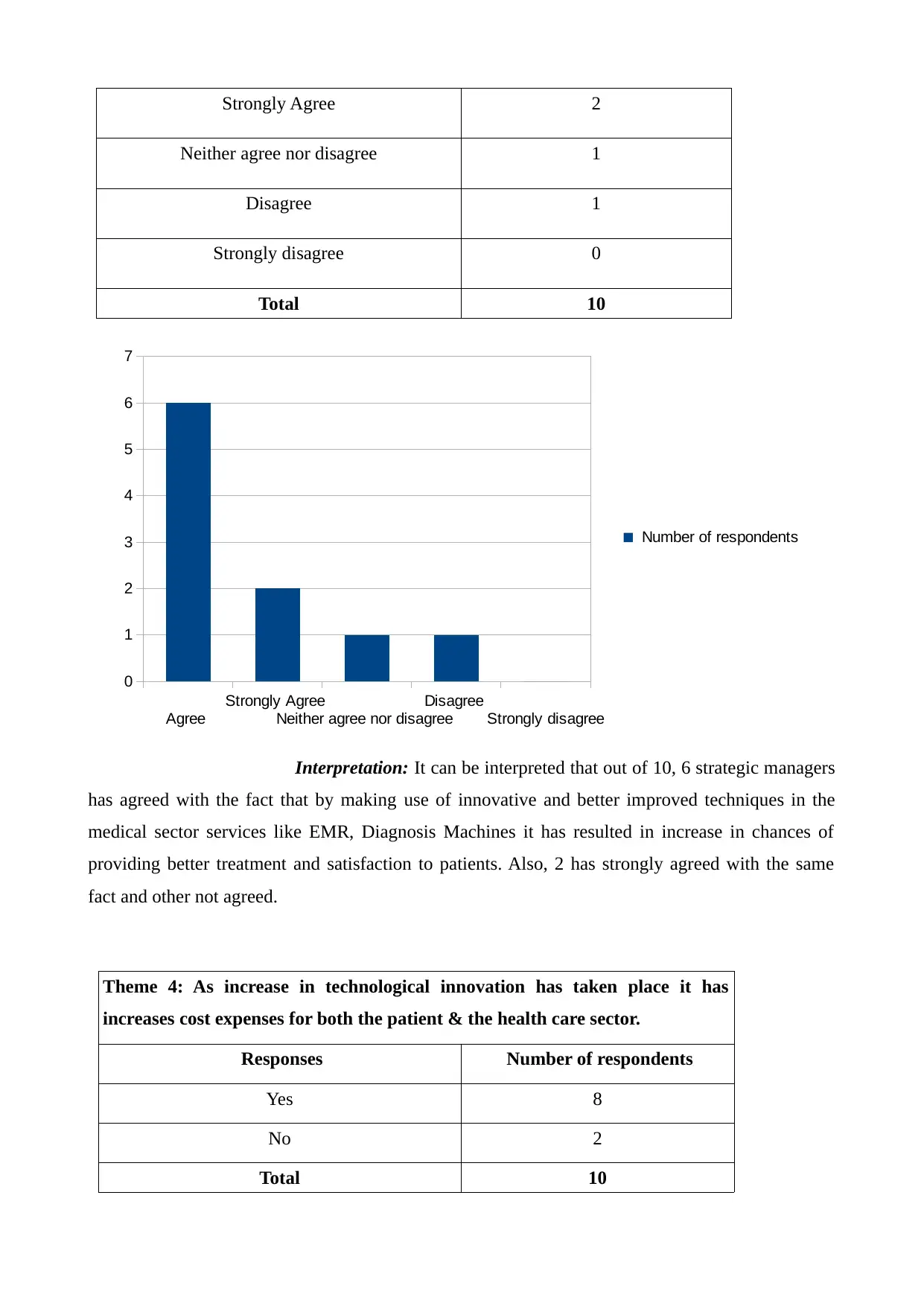
Strongly Agree 2
Neither agree nor disagree 1
Disagree 1
Strongly disagree 0
Total 10
Interpretation: It can be interpreted that out of 10, 6 strategic managers
has agreed with the fact that by making use of innovative and better improved techniques in the
medical sector services like EMR, Diagnosis Machines it has resulted in increase in chances of
providing better treatment and satisfaction to patients. Also, 2 has strongly agreed with the same
fact and other not agreed.
Theme 4: As increase in technological innovation has taken place it has
increases cost expenses for both the patient & the health care sector.
Responses Number of respondents
Yes 8
No 2
Total 10
Agree
Strongly Agree
Neither agree nor disagree
Disagree
Strongly disagree
0
1
2
3
4
5
6
7
Number of respondents
Neither agree nor disagree 1
Disagree 1
Strongly disagree 0
Total 10
Interpretation: It can be interpreted that out of 10, 6 strategic managers
has agreed with the fact that by making use of innovative and better improved techniques in the
medical sector services like EMR, Diagnosis Machines it has resulted in increase in chances of
providing better treatment and satisfaction to patients. Also, 2 has strongly agreed with the same
fact and other not agreed.
Theme 4: As increase in technological innovation has taken place it has
increases cost expenses for both the patient & the health care sector.
Responses Number of respondents
Yes 8
No 2
Total 10
Agree
Strongly Agree
Neither agree nor disagree
Disagree
Strongly disagree
0
1
2
3
4
5
6
7
Number of respondents
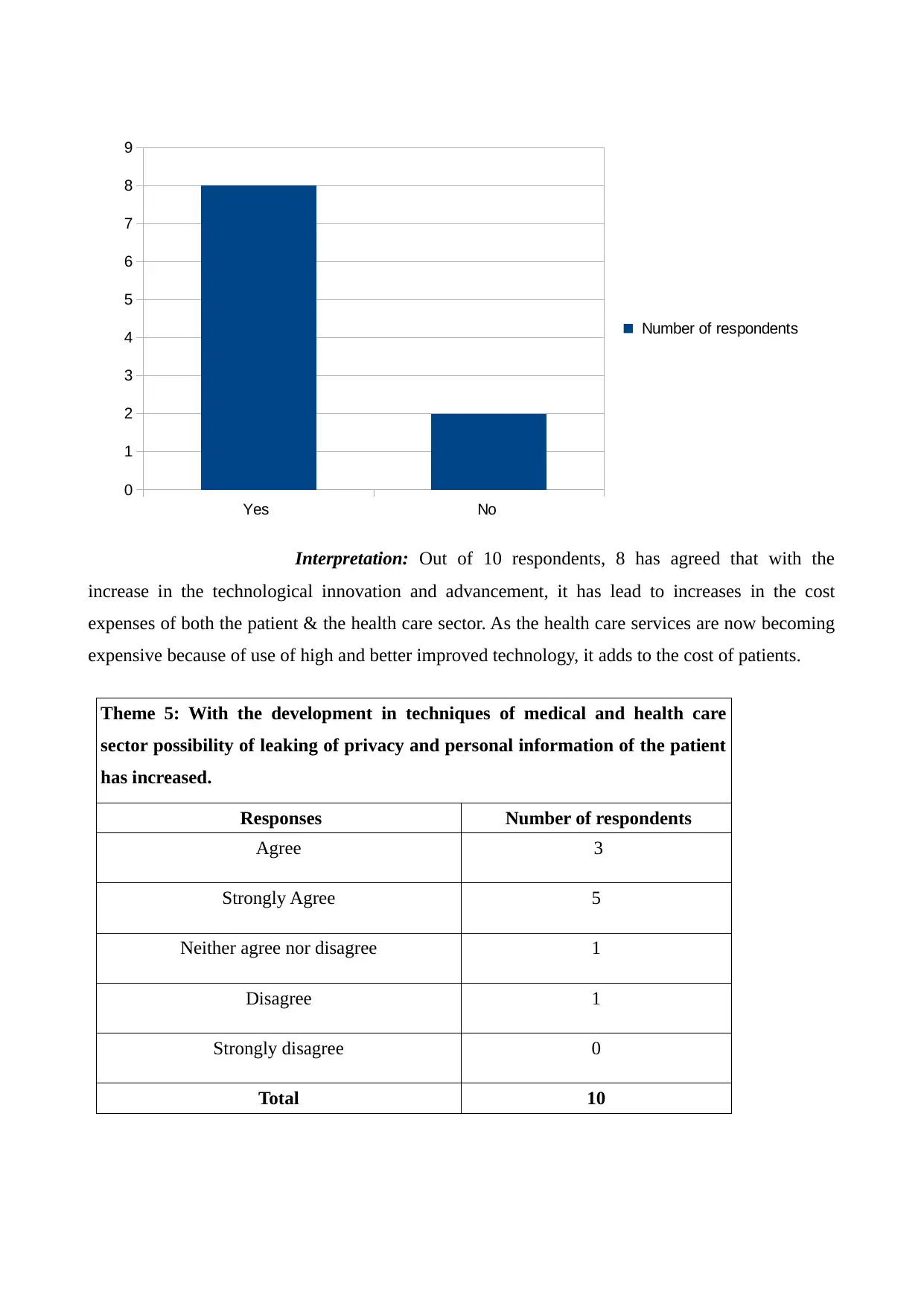
Interpretation: Out of 10 respondents, 8 has agreed that with the
increase in the technological innovation and advancement, it has lead to increases in the cost
expenses of both the patient & the health care sector. As the health care services are now becoming
expensive because of use of high and better improved technology, it adds to the cost of patients.
Theme 5: With the development in techniques of medical and health care
sector possibility of leaking of privacy and personal information of the patient
has increased.
Responses Number of respondents
Agree 3
Strongly Agree 5
Neither agree nor disagree 1
Disagree 1
Strongly disagree 0
Total 10
Yes No
0
1
2
3
4
5
6
7
8
9
Number of respondents
increase in the technological innovation and advancement, it has lead to increases in the cost
expenses of both the patient & the health care sector. As the health care services are now becoming
expensive because of use of high and better improved technology, it adds to the cost of patients.
Theme 5: With the development in techniques of medical and health care
sector possibility of leaking of privacy and personal information of the patient
has increased.
Responses Number of respondents
Agree 3
Strongly Agree 5
Neither agree nor disagree 1
Disagree 1
Strongly disagree 0
Total 10
Yes No
0
1
2
3
4
5
6
7
8
9
Number of respondents
⊘ This is a preview!⊘
Do you want full access?
Subscribe today to unlock all pages.

Trusted by 1+ million students worldwide
1 out of 15
Related Documents
Your All-in-One AI-Powered Toolkit for Academic Success.
+13062052269
info@desklib.com
Available 24*7 on WhatsApp / Email
![[object Object]](/_next/static/media/star-bottom.7253800d.svg)
Unlock your academic potential
Copyright © 2020–2025 A2Z Services. All Rights Reserved. Developed and managed by ZUCOL.





